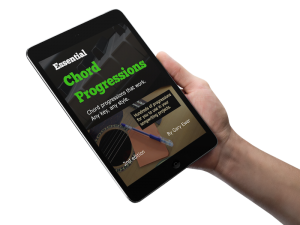If you’ve gotten partway through your next song, but you can’t seem to finish it, one of the best techniques for breaking the logjam is to take one aspect of your song and drastically change it.
It can sound ridiculous at the time, but it can work. For example, if you’ve been working on something in the metal genre, see what happens when you switch temporarily to making it sound like a country hit song.
 There’s more to a song hook than meets the ear… a lot more. “Hooks and Riffs: How They Grab Attention, Make Songs Memorable, and Build Your Fan Base” is a vital manual for any serious songwriter.
There’s more to a song hook than meets the ear… a lot more. “Hooks and Riffs: How They Grab Attention, Make Songs Memorable, and Build Your Fan Base” is a vital manual for any serious songwriter.
The reason you’d do this is not to try in any deliberate way to switch genres on your fanbase. The reason you’d do this is because it can provide a positive “shock” to your creative mind, and get you out of the rut that has you stuck in your process.
More often than not, when you return to working on the song in a “serious” way, you find yourself feeling more creative, and coming up with more ideas.
Not everything you try will necessarily work. But here are some other things you can do to shock your creative mind and have some fun, and you can even try several ideas at the same time:
- Speed up a slow song, or slow down a fast song. Radically changing the tempo brings different moods to the forefront, and might actually change your mind about the direction your song should take.
- Raise the key until you’re singing at the highest part your vocal range. Experimenting with range is a really great tool, because every time you move a song up or down, it brings out different aspects of your vocal tone. For example, a ballad could be sung faster, in a higher range, which will completely change its character.
- Change the time signature. Almost all pop songs are in 4/4 time, so see what it sounds like to change to, let’s say, 3/4. In order to do this you’ll need to shorten up some of the rhythms at the start or the end of the 4/4 bar. You’ll find that this isn’t as complicated as you might think. Let your instincts guide you here.
- Change the performance style. If you’ve been strumming your way through your song, try finger picking. If you’re playing some other keyboard-based chording instrument, like piano, see what it sounds like to play arpeggios (broken chords).
- Change the instrumentation. It can be fun to take a song you’ve been working on with your guitar, and switch to ukulele, mandolin or banjo. When you’re trying to shock your creative mind, the weirder the better!
As I say, the purpose here isn’t necessarily to make these changes permanent. They’re meant more as a way of stimulating your creative mind, and free your thought processes up a bit.
Everyone gets stuck one in a while, and if you find that every time you return to a song you get that same “I’m stuck” feeling, it’s because the song is leading you down the same creative path.
The best way off of that creative path is to do something unexpected — something unique, even funny. You might be surprised that some ideas that were meant just as a fun way to free up your mind might be ideas that you end up keeping.
 Written by Gary Ewer. Follow Gary on Twitter.
Written by Gary Ewer. Follow Gary on Twitter.
 Looking for lists of progressions you can use in your own songs? “The Essential Secrets of Songwriting” eBook Bundle has 2 main collections, plus eBooks on how to harmonize your own melodies, and more.
Looking for lists of progressions you can use in your own songs? “The Essential Secrets of Songwriting” eBook Bundle has 2 main collections, plus eBooks on how to harmonize your own melodies, and more.










